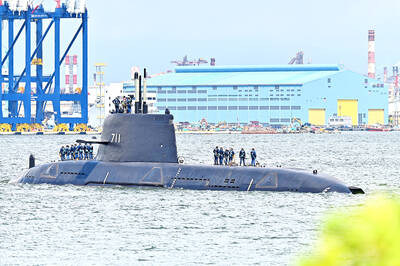Europe is giving US-led calls for a boycott of Huawei Technologies Co’s (華為) 5G telecoms equipment a mixed reception, with some governments untroubled by spy suspicions against the Chinese giant, but others backing a ban.
In the latest setback for the company, Huawei on Saturday said it had fired an employee in Poland who was arrested there a day earlier on suspicion of spying for China.
The company said it has “decided to terminate the employment of Mr Wang Weijing [王偉晶], who was arrested on suspicion of breaking Polish law.”
Polish authorities on Friday said they arrested Wang, a Chinese citizen and former diplomat, along with a Polish cybersecurity expert who also worked at the telecom company Orange.
State television identified the Polish man as Piotr D, and said he was a high-ranking employee at the Polish Internal Security Agency.
Huawei said Wang’s actions “have no relation to the company” and that he was fired because “the incident in question has brought Huawei into disrepute.”
The arrest rekindled tensions between China and the West over cybersecurity concerns surrounding Huawei. It is the world’s biggest maker of telecommunications equipment, but has been banned in the US since 2012 over fears it is a security risk.
Tensions over Huawei have intensified since Canada arrested chief financial officer Meng Wanzhou (孟晚舟) last month at the request of US authorities.
Several Asian and Pacific countries have followed Washington’s call for a Huawei ban, but the picture in Europe is more nuanced, not least because Huawei’s 5G capabilities are so attractive.
They are well ahead of Sweden’s Ericsson AB, Finland’s Nokia Oy and South Korea’s Samsung Electronics Co, analysts say.
“Operators have looked at alternatives, but have realized that Huawei is currently more innovative and probably better for 5G,” Fitch Solutions analyst Dexter Thillien said.
Portugal’s main operator MEO signed a deal with Huawei last month during a visit by Chinese President Xi Jinping (習近平), praising the Chinese company’s “know how, competence, talent and capacity to develop technology and invest in our country.”
By contrast Norway, whose networks are for the most part made up of Huawei equipment, is thinking of ways to reduce its “vulnerability,” the country’s transport and communications minister was quoted in the local press as saying.
British Minister of State for Defense Affairs Gavin Williamson said he had “grave, very deep concerns about Huawei providing the 5G network in Britain.”
The Czech cybersecurity agency said that Chinese laws “force private companies with their headquarters in China to cooperate with intelligence services,” which could make them “a threat.”
Germany is under pressure from Washington to follow suit, Der Spiegel reported, but the country’s IT watchdog says it has found no evidence that Huawei could use its equipment to spy for Beijing.

LONG FLIGHT: The jets would be flown by US pilots, with Taiwanese copilots in the two-seat F-16D variant to help familiarize them with the aircraft, the source said The US is expected to fly 10 Lockheed Martin F-16C/D Block 70/72 jets to Taiwan over the coming months to fulfill a long-awaited order of 66 aircraft, a defense official said yesterday. Word that the first batch of the jets would be delivered soon was welcome news to Taiwan, which has become concerned about delays in the delivery of US arms amid rising military tensions with China. Speaking on condition of anonymity, the official said the initial tranche of the nation’s F-16s are rolling off assembly lines in the US and would be flown under their own power to Taiwan by way

OBJECTS AT SEA: Satellites with synthetic-aperture radar could aid in the detection of small Chinese boats attempting to illegally enter Taiwan, the space agency head said Taiwan aims to send the nation’s first low Earth orbit (LEO) satellite into space in 2027, while the first Formosat-8 and Formosat-9 spacecraft are to be launched in October and 2028 respectively, the National Science and Technology Council said yesterday. The council laid out its space development plan in a report reviewed by members of the legislature’s Education and Culture Committee. Six LEO satellites would be produced in the initial phase, with the first one, the B5G-1A, scheduled to be launched in 2027, the council said in the report. Regarding the second satellite, the B5G-1B, the government plans to work with private contractors

MISSION: The Indo-Pacific region is ‘the priority theater,’ where the task of deterrence extends across the entire region, including Taiwan, the US Pacific Fleet commander said The US Navy’s “mission of deterrence” in the Indo-Pacific theater applies to Taiwan, Pacific Fleet Commander Admiral Stephen Koehler told the South China Sea Conference on Tuesday. The conference, organized by the Center for Strategic and International Studies (CSIS), is an international platform for senior officials and experts from countries with security interests in the region. “The Pacific Fleet’s mission is to deter aggression across the Western Pacific, together with our allies and partners, and to prevail in combat if necessary, Koehler said in the event’s keynote speech. “That mission of deterrence applies regionwide — including the South China Sea and Taiwan,” he

‘NARWHAL’: The indigenous submarine completed its harbor acceptance test recently and is now under heavy guard as it undergoes tests in open waters, a source said The Hai Kun (海鯤), the nation’s first indigenous defense submarine, yesterday began sea trials, sailing out of the Port of Kaohsiung, a military source said. Also known as the “Narwhal,” the vessel departed from CSBC Corp, Taiwan’s (台灣國際造船) shipyard at about 8am, where it had been docked. More than 10 technicians and military personnel were on deck, with several others standing atop the sail. After recently completing its harbor acceptance test, the vessel has started a series of sea-based trials, including tests of its propulsion and navigational systems, while partially surfaced, the source said. The Hai Kun underwent tests in the port from